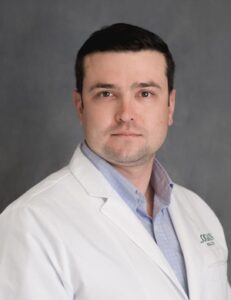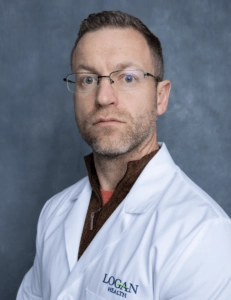The pediatric neurologists at Logan Health Children’s Specialists study and treat the brain, spine and nervous system in children and adolescents. As a department of Logan Health Medical Center we care for patients from birth through age 21. We specialize in the diagnosis of seizures and epilepsy syndromes and appropriate medical treatment of those conditions.
Conditions Treated
- Abnormal head, brain or face shape and size
- Concussion and brain or spine injury
- Epilepsy and seizures
- Genetic disorder
- Hydrocephalus and Chiari malformation
- Hypotonia
- Meningitis, encephalitis and other infections of the nervous system
- Migraine and headache
- Movement disorder
- Neurocutaneous syndromes
- Neurometabolic disorder
- Neuromuscular disorder
- Shaken baby syndrome
- Stroke and vascular disease
- Syncope
- White matter and neuroimmunological disorders
Services and Procedures
- Management of the above conditions
- Diagnostic and therapeutic lumbar puncture (performed by Dr. Wheeler in Logan Health Medical Center’s same-day surgery department)
- Routine electroencephalogram (EEG) interpretation (read by Dr. Wheeler, available at all local and outreach clinic locations)
- Continuous video EEG monitoring (extended monitoring performed at Logan Health Medical Center)
- Neuroimaging (CT and MRI) interpretation
- Electromyography (EMG) and nerve conduction studies (performed at the Logan Health Neuroscience & Spine)
Patient Forms
Conditions and Treatments
ABNORMAL HEAD, BRAIN OR FACE SHAPE AND SIZE
What is abnormal head, brain or face shape or size?
If a child’s head is larger or smaller than expected for his or her age, measurements and testing may be done to determine whether there is a disorder of head or brain development. Examples of such disorders include lissencephaly, heterotopia, plagiocephaly, Chiari malformation, Dandy-Walker syndrome, microcephaly and macrocephaly. These disorders may affect the child’s development, movement and learning.
How is it treated?
If a child is diagnosed with abnormal head shape or size, a neurologist can help guide the management of the condition and advise the parents regarding long-term prognosis.
CONCUSSION AND BRAIN OR SPINE INJURY
What is a concussion?
A concussion is a mild injury to the brain caused by a sudden blow to the head. Children often bump or hit their heads without getting a concussion. Signs and symptoms of a concussion can include headache, dizziness, vomiting, confusion, acting dazed, amnesia, loss of consciousness, mood changes and fatigue.
How is it treated?
A neurologist can help with short- or long-term management of the above symptoms after a concussion, including return to school and sports.
Learn More
www.biausa.org
EPILEPSY AND SEIZURES
What is epilepsy?
Epilepsy is a chronic brain disorder that causes recurring, unpredictable seizures. Epileptic seizures can range from almost undetectable to temporarily disabling. Symptoms of a seizure include muscle spasms, vision changes, difficulty breathing and even loss of consciousness.
How is it treated?
Emergency medications are sometimes necessary to treat prolonged or repeated seizures. Your neurologist may prescribe an emergency medication such as Diastat for these situations. Get emergency medical help if a seizure lasts longer than five minutes.
Learn More
www.epilepsy.com
GENETIC DISORDER
What is a genetic disorder?
Genetic mutations sometimes occur when there is a change in a gene or genes, causing a genetic disorder. Genetic disorders are often inherited from one or both parents. Genetic disorders of the nervous system include Angelman syndrome, Rett syndrome and fragile X syndrome. Genetic disorders can affect brain development and lead to developmental delays, seizures, movement disorders or learning disabilities.
How is it treated?
A neurologist can help with diagnosis and management of genetic disorders. The type of treatment varies depending on the disorder.
HYDROCEPHALUS AND CHIARI MALFORMATION
What are hydrocephalus and Chiari malformation?
Hydrocephalus is the buildup of cerebrospinal fluid inside the brain, putting pressure on the brain and potentially causing brain damage. Chiari malformation is a condition in which brain tissue extends down into the spinal canal, often accompanied by an excess of fluid in the brain.
How are they treated?
To reduce pressure on the brain, a surgeon can place a cerebrospinal fluid shunt, which diverts the excess fluid into another part of the body and reduces pressure on the brain. Our surgeons are skilled in this procedure. Children and adolescents with these conditions generally require ongoing surveillance by a neurologist to identify and manage complications with the assistance of a trained neurosurgeon.
HYPOTONIA
What is hypotonia?
Hypotonia means low muscle tone throughout the body. Hypotonia may first appear in a newborn and can be caused by a variety of neurological conditions.
How is it treated?
Neurologists help to diagnose the cause of hypotonia and can help to manage the consequences of that diagnosis. It is often also necessary to pursue early intervention with physical therapy to help maximize the child’s development.
MENINGITIS, ENCEPHALITIS AND OTHER INFECTIONS OF THE NERVOUS SYSTEM
What is an infection of the nervous system?
The nervous system, like any other organ system in the body, can become infected by a variety of organisms including bacteria, viruses and parasites. These infections are quite serious and can result in significant disability and death.
How is it treated?
Neurologists are part of the treatment team involved in such cases to help with treatment of the initial infection and management of any long-term consequences of infection, including stroke, seizures or epilepsy, and behavioral or learning difficulties.
MIGRAINE AND HEADACHE
What is a migraine?
A migraine is a moderate to severe headache lasting between 30 minutes and several days. Migraines are often accompanied by nausea, vomiting or sensitivity to light and sound. Other symptoms include visual disturbances (seeing bright lights or colors), numbness, dizziness or difficulty concentrating.
How is it treated?
A neurologist is skilled in diagnosing migraine and other headache types and offering options for management and prevention. Treatments may include avoiding migraine triggers and taking medications to prevent migraines or relieve symptoms.
Learn More
www.headaches.org
MOVEMENT DISORDER
What is a movement disorder?
When a person’s body moves too much or too little, this can be a movement disorder. Types of movement disorders include motor or vocal tics, tremors, coordination problems (ataxia), involuntary muscle contractions (dystonia) or abrupt involuntary movements (chorea). These conditions can be caused by medications, infections or a range of other neurological disorders.
How is it treated?
Movement disorders can be diagnosed and treated by a neurologist. Treatment options may include medications, physical therapy or surgery.
Learn More
Tourette Syndrome Association: www.tsa-usa.org
National Ataxia Foundation: www.ataxia.org
Cerebral Palsy Foundation: www.ucp.org
NEUROCUTANEOUS SYNDROMES
What are neurocutaneous syndromes?
Neurocutaneous syndromes are genetic disorders that affect the development of the skin and the nervous system, often resulting in the growth of tumors in the skin and nervous system. Such disorders include neurofibromatosis, tuberous sclerosis and Sturge-Weber syndrome.
How are they treated?
A neurologist is important for surveillance over time, as neurological symptoms including pain, weakness, seizures and learning difficulties are common.
Learn More
www.tsalliance.org
NEUROMETABOLIC DISORDER
What is a neurometabolic disorder?
Neurometabolic disorders are genetic disorders that disrupt how the body uses or produces energy from food, due to either an accumulation of harmful substances or a deficiency of necessary substances. This may lead to disorders of development, seizures or epilepsy, movement disorders, vision or hearing impairment, weakness or other neurological symptoms.
How is it treated?
Neurologists are helpful in diagnosing such disorders and work with metabolic specialists to treat the symptoms of these disorders.
NEUROMUSCULAR DISORDER
What is a neuromuscular disorder?
A neuromuscular disorder affects the nervous system as well as the strength and tone of muscles. Neuromuscular disorders can involve the brain, spinal cord, peripheral nerves, neuromuscular junction or the muscles themselves. Common disorders include:
- Muscular dystrophies (Duchenne and Becker muscular dystrophies, limb girdle muscular dystrophy, myotonic dystrophy, congenital dystrophies)
- Myopathies (congenital and metabolic)
- Myasthenia gravis and congenital myasthenic syndrome
- Spinal muscular atrophy
- Peripheral neuropathies (acquired neuropathies such as Bell’s palsy and Guillain-Barré syndrome and hereditary neuropathies such as Charcot-Marie-Tooth)
- Inflammatory myopathies (dermatomyositis, polymyositis)
How is it treated?
Many neuromuscular disorders have no cure, but they can be treated and managed with help from a neurologist and other specialists.
Learn More
www.mda.org
SHAKEN BABY SYNDROME
What is shaken baby syndrome?
Shaken baby syndrome, or abusive head trauma, describes injury to a child’s brain as a result of head trauma. This can be caused by direct blows to the head, or by dropping or shaking a child. Shaken baby syndrome is most common in infants younger than 1 year old. This type of brain injury can result in long-term developmental delays and learning difficulties, irritability, ADD/ADHD, and seizures or epilepsy.
How is it treated?
A neurologist is important for the long-term management of complications from shaken baby syndrome.
Learn More
www.dontshake.org
STROKE AND VASCULAR DISEASE
What is a stroke?
Stroke is a term for damage to the brain caused by an interruption in blood flow and oxygen. Stroke in children can be caused by clotting disorders, trauma, heart disease or metabolic disorders. Hypoxic ischemic encephalopathy is brain injury to an infant caused by a lack of oxygen before, during or after birth.
How is it treated?
A neurologist is helpful in identifying the underlying cause of the stroke as well as managing long-term consequences of stroke, such as developmental delay, weakness or seizures.
SYNCOPE
What is syncope?
Syncope, or fainting, is a common symptom affecting children and adolescents. It is caused by a brief period of inadequate blood flow to the brain, resulting in a brief loss of consciousness. This can be due to a quick change in body position, a dysfunction in the regulation of blood pressure or irregular heart rhythms.
How is it treated?
It is often important to see both a neurologist and a cardiologist to evaluate the symptoms and reach a diagnosis. In the absence of heart disease, fainting is often a benign and temporary condition treated conservatively with changes to sleeping patterns, diet, water intake and exercise. Fainting often can be confused with seizures, as many patients may have some stiffening and shaking following a loss of consciousness. An electroencephalogram can be helpful to distinguish one from the other if the situation is unclear.
WHITE MATTER AND NEUROIMMUNOLOGICAL DISORDERS
What is a neuroimmunological disorder?
There are a wide variety of immunological disorders in which the human immune system malfunctions and attacks parts of the nervous system, such as portions of the brain, spine, nerves or muscles. One of the most common diseases of this type is multiple sclerosis.
How is it treated?
A neurologist is important in the diagnosis of such conditions as well as the short- and long-term management of symptoms.
Meet Our Team
Locations

Logan Health Specialty Care – Great Falls

Logan Health Specialty Care – Helena

Logan Health Specialty Care – Missoula
Additional Locations
Diabetes self-management education and prevention services also are offered at the following locations. We offer telehealth education at Northern Rockies Medical Center in Cut Bank and Clark Fork Valley Hospital in Plains.
Cabinet Peaks Medical Center
209 Health Park Drive
Libby, MT 59923
(406) 283-7319
Eureka Healthcare Primary Care
304 Osloski Road
Eureka, MT 59917
(406) 297-3145
Pondera Medical Center
805 Sunset Blvd
Conrad, MT 59425
(406) 271-3211
Contact Us
Logan Health Children’s Specialists
202 Conway Drive, Suite 200
Kalispell, MT 59901
Phone and Fax
Phone: (406) 758-7490
Fax: (406) 758-7080
Office Hours
Monday through Thursday 8 a.m. to 5 p.m.



